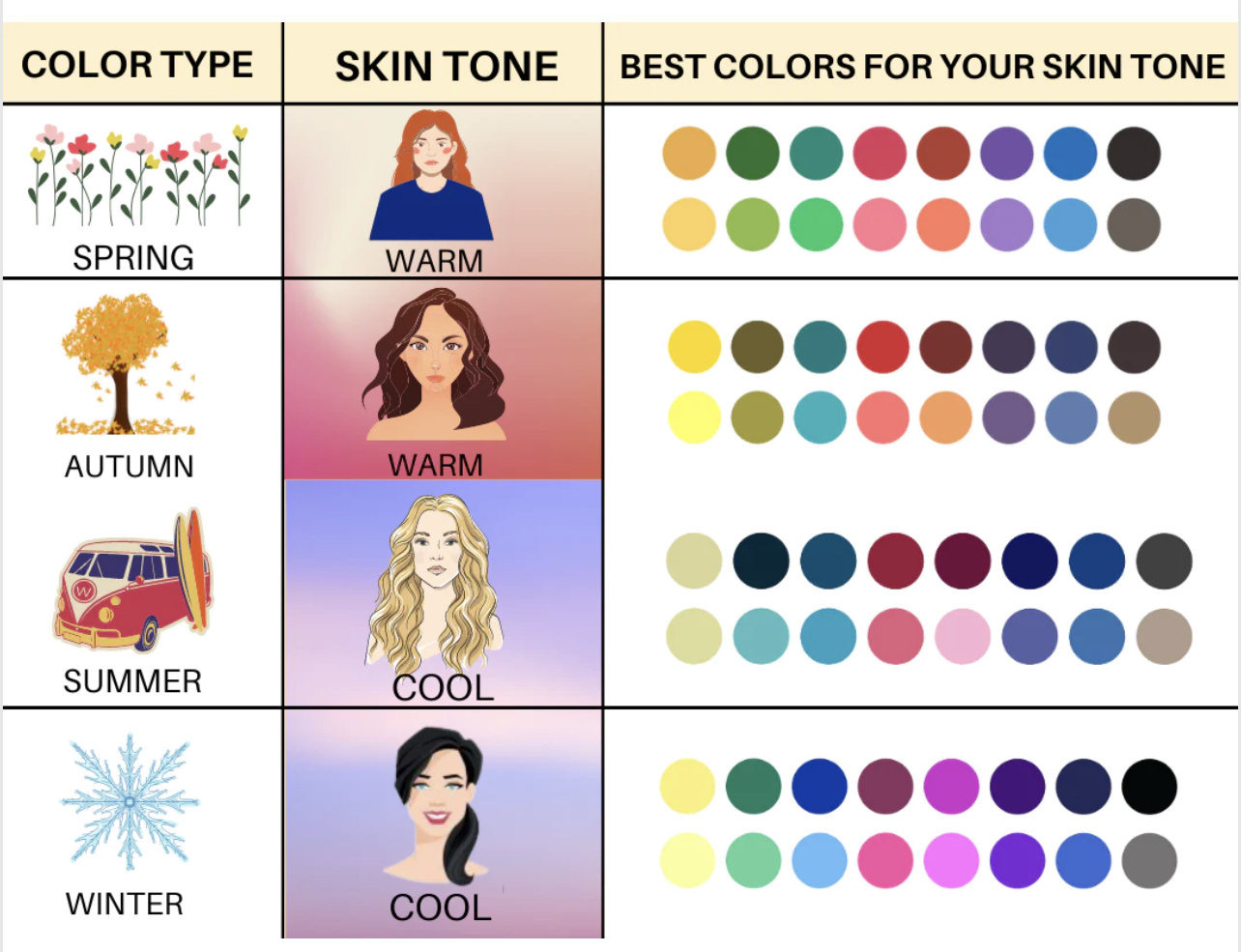Dive into the vibrant world of cool colors, including blues, purples, and greens. These hues have a soothing effect that can transform your look, your home, and even your mood. From calming blues to refreshing greens, cool colors offer a versatile palette for evoking tranquility, professionalism, and a touch of mystery. Get ready to embrace the cool side of the spectrum and discover a world of tranquility, sophistication, and endless possibilities.
Unlocking the Power of Cool Tones
We’re diving deep into cool-toned colors—those shades that evoke a relaxing day by the ocean. Think blues, purples, greens, and even certain pinks. But what makes these colors so “cool?” And how can you use them effectively in fashion and design? Let’s break it down:
What Defines a “Cool” Color?
Cool colors are like the introverts of the color world, often appearing more subdued than their warm-toned counterparts—think fiery reds and oranges. They often remind us of calming natural scenes like peaceful blue skies, lush green forests, and crystal-clear water. This doesn’t mean they’re boring, though! Cool colors add a touch of mystery and depth. They can even make a space feel larger and more open.
How Cool Colors Influence Your Mood
Ever notice how a blue room makes you feel relaxed while a purple one feels luxurious? That’s no coincidence! Colors have a subtle way of influencing our emotions:
- Blue is often linked to feelings of peace, trust, and stability. This is probably why it’s a popular choice for bedrooms and bathrooms.
- Green is associated with nature, growth, harmony, and a sense of balance.
- Violet is linked with royalty, luxury, creativity, and imagination.
Cool Colors in Fashion
Understanding cool tones is key to figuring out which colors will flatter you most. People with cool undertones (think pinkish or bluish hints in their skin) often look incredible in colors like:
- Jewel Tones: Deep emerald green, sapphire blue, and ruby red.
- Soft Pinks: Think blush, rose, or dusty rose.
- Cool Grays: Charcoal, slate, and silver.
Cool Colors in Interior Design
Want to create a space that feels serene and inviting? Cool tones are your new best friend! Imagine a bedroom painted a calming blue or a living room with accents of sage green.
Here are some ways to incorporate cool colors in your home:
- Walls: Light blues and greens can make a room feel spacious and airy.
- Furniture: Consider a navy blue sofa or a forest green accent chair.
- Decor: Throw pillows, rugs, and artwork are great ways to add pops of cool tones. Searching for a home renovation that elegantly combines rustic and modern styles? Look no further than city loft Sherwin Williams! This design aesthetic seamlessly merges exposed brick walls with sleek furnishings, creating a captivating industrial-chic atmosphere.
Exploring the Five Cool Colors
So, we’ve been talking about cool colors and how they can transform a space or an outfit, but which colors are we actually talking about? Let’s meet the core members of the cool color family:
- Blue: If you had to pick a color that embodies trust and dependability, it would probably be blue. It’s often used by businesses to appear professional and stable.
- Green: Represents growth, harmony, and that fresh, natural feeling. It’s like a dose of peace and balance for your eyes.
- Violet: This color is a bit more mysterious and luxurious, often associated with royalty, creativity, and spirituality.
Expanding the Cool Color Palette
The cool color family extends beyond just blue, green, and violet.
- Shades and Variations: Think teal (a gorgeous blue-green), aquamarine, indigo (a deep, almost mystical blue), and lavender.
- Temperature Tweaks: Even warm colors like red can have cool-toned variations. For example, crimson (a deep red with a hint of blue) or burgundy.
Cool Colors in Action
- Branding and Marketing: Companies use colors to send subtle messages. Tech companies often use blue to convey trust and reliability, while green is often used by eco-friendly brands.
- Interior Design: Rooms decorated in cool colors often feel more relaxed and inviting. These colors can make spaces feel bigger and airier, creating a serene and focused atmosphere—perfect for a bedroom or home office!
- Fashion: Cool colors often flatter people with cooler skin tones—think rosy pink or bluish undertones. Emerald green, sapphire blue, blush pink, and cool grays can all make these complexions pop! If you’re seeking inspiration for a bathroom that exudes both sophistication and functionality, explore our curated gallery of contemporary powder room ideas. From minimalist designs to luxurious oases, we’ve gathered an array of concepts that will spark your creativity and transform your powder room into a stylish retreat.
Decoding Cool Tones: Which Colors Fit the Bill?
We’ve explored the world of warm colors, but what about their cooler counterparts? Cool-toned colors, often associated with calmness and serenity, occupy the opposite side of the color wheel from warm tones—think reds, oranges, and yellows. However, it’s not as simple as just blues, greens, and purples. A whole range of shades falls under this category!
Even colors we usually consider neutral, like gray, beige, and white, can have cool or warm undertones, much like human skin. This subtle difference can completely change the vibe of a room. Understanding the nuances of cool tones can be a game-changer for design enthusiasts.
Think about how different colors make you feel. Cool tones are known for creating a sense of calmness and serenity, almost like a mental vacation. That’s why they’re frequently used in spaces designed for relaxation and unwinding, like bedrooms and bathrooms. They can also lend a sophisticated air to offices.
Here’s a quick recap:
- What colors are cool-toned? Primarily blues, greens, purples, and even some grays.
- How do they make you feel? Think calmness, serenity, and peace.
- How do they change a room? They can make a room feel bigger, airier, and more sophisticated.
- What about art? In art, cool colors create depth and contrast, making objects appear farther away.
- Do they look good on everyone? They flatter people with naturally cool undertones in their skin.
Are You Cool-Toned or Warm-Toned?
We’ve established that cool colors—serene blues, tranquil greens, and luxurious purples—can have a powerful impact on mood and design. But how can you tell if these colors flatter you? Let’s explore the fascinating world of cool-toned individuals.
Unlocking the Secrets of Cool Tones
Have you ever noticed how some people just radiate in certain colors? That’s their skin’s undertone at work! Cool undertones have a bluish or pink base, meaning they look incredible in—you guessed it—cool colors!
Signs You Might Be Cool-Toned
Not sure if you fall into the cool camp? Here are some clues:
- Veins: Do the veins on the underside of your wrist appear more blue or purple? That’s a strong indicator of cool undertones.
- Jewelry: Does silver jewelry enhance your skin tone? Cool tones are usually drawn to silver over gold.
- Sun Response: Do you burn easily? Cool skin often burns before it tans.
- Clothing Colors: Do certain colors make you look washed out while others make you glow? Cool tones generally look radiant in blues, greens, purples, and some pinks—think emerald green, sapphire blue, or deep plum. They might also rock black, white, and cool grays.
The Cool Tone Spectrum
Just like cool colors themselves, cool skin tones come in a variety of shades:
- Fair Cool: This skin tone is very fair and might have a rosy blush.
- Light Cool: Think porcelain skin with pink or blue undertones.
- Medium Cool: This skin tone has a beige base with a hint of pink or blue.
- Deep Cool: Think deeper, richer complexions with cool undertones.
Remember, these are just guidelines! Skin tones are unique, and some people have both warm and cool undertones.
Embracing Your Cool Side
Discovering that you have a cool skin undertone opens up a world of flattering colors and styles to explore. However, don’t be afraid to experiment! The most important thing is to feel confident and comfortable in your own skin.
- Kitchen Backsplash For White Kitchen: Ideas To Inspire Your Renovation - November 21, 2025
- White On White Kitchen Backsplash: Is It Timeless? - November 20, 2025
- Backsplash Colors for White Cabinets: Find Your Perfect Match - November 19, 2025










